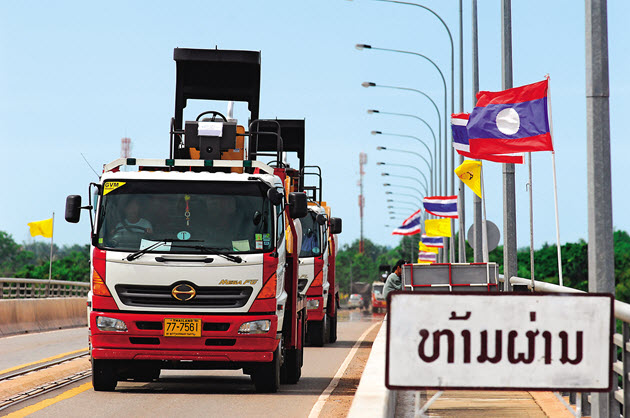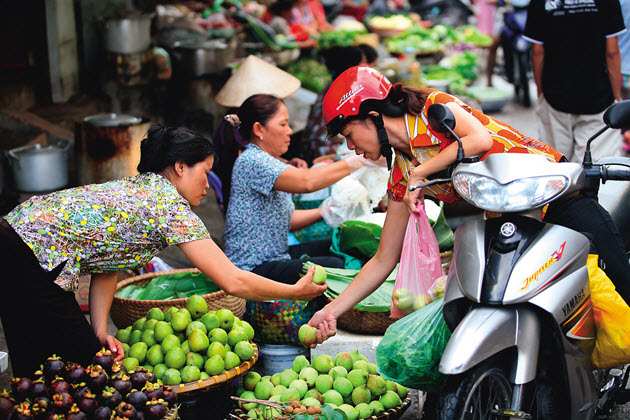The Greater East Asia Market
Where Does Taiwan Fit In?

Source:CW
ASEAN is now Taiwan's second largest export market, making Taiwan's participation in an integrated East Asia essential. The next five years will determine whether that happens.
Views
Where Does Taiwan Fit In?
By Monique HouFrom CommonWealth Magazine (vol. 434 )
As Taiwan struggles to hammer out a cross-strait economic framework agreement (or "ECFA") that will guarantee market access to China, the stakes could not be higher: The Association of Southeast Asian Nations' (ASEAN) is set to join with China, South Korea and Japan to form a vast integrated trade zone.
This economic body, with a population of 2 billion, will be the world's largest market, with the world's greatest growth potential.
ASEAN is taking on a completely new significance to the rest of the world.
"It's always been called the Association of Southeast Asian Nations, but where, in fact, was this association in the past? They were all small individual countries. But next year will be different, as trade is gradually liberalized and ASEAN and China become a trade zone. That means the management philosophy will have to be different," says Kevin Lee, the vice president of chemicals producer Namchow Group. "As soon as it's opened, we'll make our move."
He is referring to the company's targeting of ASEAN and western China as prime markets for its fourth oil and fat factory. "It will provide a huge boost to Namchow's results."
Why Will Next Year Be Different?
Three major milestones in East Asian economic integration will be achieved on Jan. 1, 2010.
Milestone 1: The transition period for the six original ASEAN member countries (Thailand, Malaysia, Singapore, Indonesia, the Philippines, and Brunei) will formally come to an end, and they will establish a truly integrated economic entity.
Milestone 2: The six original ASEAN members will formally create a free trade zone with China in which 93 percent of goods traded within the zone will receive duty-free treatment.
Milestone 3: ASEAN and South Korea will form a free trade zone.
The "New Asia" set to emerge when ASEAN and the three big Northeast Asian economies (China, Japan and South Korea) become integrated early next year stands to be the world's biggest new market with the greatest growth potential.
In five years, this new entity will balloon into an even bigger free trade zone, with the addition of India, New Zealand and Australia.
These three milestones, in which ASEAN is the common denominator, will also have a decisive impact on the future of Taiwan's foreign trade. Taiwan has been excluded so far from the club and fears being marginalized economically in the region.
"This is like an office where workers form little cliques. If you don't belong to any of the cliques, in the end you'll be left out," says Chu-Chia Steve Lin, a professor in National Chengchi University's Department of Economics.
'Astonishing Energy '
Why is ASEAN at the center of East Asian economic integration?
ASEAN countries are "nothing" compared to "Chindia" (China and India), yet ASEAN is the only region capable of being in the driver's seat of the Greater East Asian integration, because of its neutral position and high bargaining power, argues Philip Kotler, the management guru hailed as the "father of modern marketing."

ASEAN is not considered a threat to Asia's leading players, such as China and Japan, and it has an attractive regional market base and a competitive regional production base that contribute to its bargaining power.
Two years ago, Kotler published a book called Think ASEAN that alerted Europe and the United States to consider ASEAN in a new light.
Namchow Group chairman Alfred Chen said his company has observed ASEAN during its 20 years in Thailand. Early efforts to integrate were generally empty rhetoric, but after China's rise, the ASEAN countries felt threatened and were compelled to set aside their mutual rivalries and come together in their approach toward the outside world. "Once they united, the synergies became clear," Chen says.
"As the region becomes integrated over the next five years, it will unleash astonishing energy fed by mutual nourishment," said Homi Kharas, a senior fellow on Global Economy and Development at the Brookings Institution and formerly a chief economist in the East Asia and Pacific Region of the World Bank, in a recent speech to businessmen in Washington. He asserted that trade links within the region were transforming East Asia into a "tightly knit region" and that these relatively fragile links would grow robust in the next 20 years.
The Dawn of a New Macromarketing Entity
Fully integrated, ASEAN will comprise a single market of 600 million people. When China, Japan and South Korea are included, the market will swell to 2 billion.

"No one can afford not to join," exclaimed an IBM analysis.
The World Bank was just as emphatic in a recent regional report in which it wrote that there are only three meaningful trade blocs in the world, with Asia's bloc representing the largest population and fastest growth. It estimated that by 2020, Asia would account for half of the world economy.
From Taiwan's perspective, the importance of ASEAN today also differs markedly from the 1980s and 1990s, when it was promoted as an investment destination for Taiwanese manufacturers looking to reduce labor costs.
In 2007, ASEAN countries surpassed the United States as Taiwan's second leading export market. (Table 1) As national borders within the zone disappear, ASEAN will quickly become "a new macromarketing entity," says Paul S.C. Hsu, a professor in Yuan Ze University's Graduate School of Management.
Japanese companies have changed their vision of ASEAN along similar lines in recent years.
"Japanese enterprises no longer see ASEAN countries as individual countries. They have adopted a regional perspective in building production networks and managing markets," says Eitaro Kojima, the managing director of the Japan External Trade Organization (JETRO) office in Yangon.
To assist Japanese companies in capitalizing on the integrated ASEAN market and production network, JETRO conducted a thorough study over the past three years on the transportation and customs clearance costs of land, ocean, and air freight transportation options on three routes – from Southeast Asia to China, the Middle East and India. The resulting report exceeds 400 pages.
"This report led many Japanese logistics companies to substantially increase their investment in this region," Kojima says.
One of them, Japan Logistic Systems Corp., announced in the middle of this year that it was investing in a 2,700 square-meter duty-free warehouse in southern Laos to help customers in Singapore, Malaysia and Thailand ship their goods via Laos' land transportation network to Vietnam and China.
The globally deployed Japanese freight consolidator Kintetsu World Express Inc. also announced that it intended to develop a presence in Laos, Burma and Cambodia. The strategy will target ASEAN countries and western China, as well as ocean freight from Burma to India and from Vietnam to the United States.
"Once regional operations get started, the whole chain will develop. It won't be a waste of resources for logistics companies and will turn into a logistics network system," Kintetsu World Express' representative in Laos, Hiro Nagamochi, told CommonWealth Magazine on a flight from Bangkok to Laos' capital Vientiane.
Using ASEAN to Attack China's Domestic Market
Namchow's Lee explains that the region's transportation system has already improved considerably.
"In the past, the only choice we had when shipping our products from Bangkok to Vietnam was to first ship them by sea to Ho Chi Minh port, which took seven days. Then to get to Hanoi in northern Vietnam, they had to travel more than 1,000 kilometers by land. Now, the goods can be shipped on the Mekong River, cutting through Laos to get to central Vietnam. From there, they are trucked to Hanoi. In all, it takes only three days," Lee says.
All ASEAN members want access to China's market, especially the underdeveloped western part of the country where the greatest potential for growth exists. But the products China imports from Southeast Asia, and the uses it has for them, are quite different from the products they import from Taiwan.
According to a study by UBS, 50 to 70 percent of China's imports from ASEAN are for domestic consumption, compared to only 30 percent of its imports from Taiwan. Most of the goods Taiwan sells to China are used in goods that are then exported overseas. These figures suggest that after ASEAN and China set up a free trade zone, Taiwanese enterprises may be more successful at carving out a share of China's domestic market by investing in export capacity in ASEAN countries.

Namchow, for instance, already has oil and fat factories in China's Tianjin and Guangzhou, but shipping goods from those plants to western China is simply not feasible. To get a foothold in the western China market, Namchow has evaluated setting up a plant in either Thailand or Vietnam, for two reasons.
The first, Lee says, is that "edible oil plants need a wide variety of raw materials, many of which cannot be found in western China." The second is that for the sake of convenience, edible oil factories should be near a port. "The ports in Guangxi fall far short of the ports in Southeast Asia in terms of scale and facilities," he explains.
Namchow's thinking illustrates China's grand scheme behind its alliance with ASEAN. From the west, it can open up routes through Burma to the Indian Ocean on one side and through Vietnam to the Pacific Ocean on the other side. Directly south, it can use Thailand and Singapore as gateways to the Middle East.
The ASEAN market itself also serves as the first step in many Chinese companies' efforts to expand into international markets. Chinese investment in ASEAN countries fell dramatically following the Asian Financial Crisis in 1997 but has rebounded strongly since 2002, on average doubling annually from 2003 to 2008. (Table 2)
Samsung Rolls In
Japanese and South Korea firms have gained footholds in Southeast Asia faster and earlier than enterprises from any other country in the world. South Korea-based Samsung has nearly 7,000 employees in its branch companies in six ASEAN countries.

Samsung began marketing its mobile phones in ASEAN telecom markets in 1999, and today has the second largest market share in the region. It started selling its home appliances in the region even earlier, setting up the first television assembly plant in Thailand in 1987, and then quickly expanding its investment in other countries in the region. It now has home appliance factories in Indonesia, Malaysia and Vietnam that complement one another and serve the entire ASEAN market.
In fact, even when product inspection was inconsistent across ASEAN countries, customs clearance procedures were complicated and import duties were high, Samsung had already set up a tight regional network. Former Samsung Group chairman Lee Kun-hee, speaking recently on East Asian integration, noted that next year after South Korea's trade pact with ASEAN takes effect, bilateral barriers to the free flow of goods, services, capital and skilled labor will be eliminated. Also, laws and regulations will be standardized and customs procedures simplified, and Lee said Samsung "is already well positioned and will definitely capitalize on the benefits of ASEAN growth."
Companies like Samsung are now helping the poorer countries in the region improve their living standards. Samsung appliances produced in Malaysia and Thailand can be purchased as far away as the Shan State in Burma's northeastern highlands, and billboards promoting Samsung products can be seen throughout the Laotian countryside.
These underdeveloped, less advanced ASEAN countries, ravaged by war in the past, are poised to be quickly brought into the ASEAN fold in the next few years, as their old battlefields are transformed into new markets.
Translated from the Chinese by Luke Sabatier
Chinese Version: 東協10+3的巨大威脅 東亞整合台灣的關鍵五年






